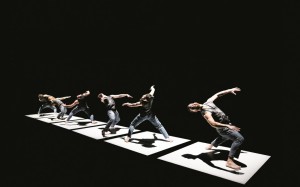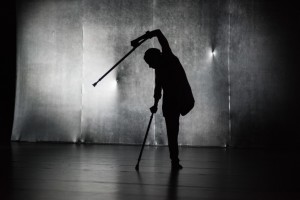The British Dance Edition is essentially a biennial trade show – an opportunity for dance companies to showcase their wares in front of promoters and producers from all around the world. 2016 saw it visit Wales for the first time, with performances taking place at Cardiff’s Chapter, Dance House and Wales Millennium Centre in Cardiff, and Newport’s Riverfront; as well as streaming online.
There were only a few shows which were open to the public – I attended the second evening presentation at the Millennium Centre.
The fun began in the venue’s cavernous but welcoming foyer, where Reckless Sleepers presented A String Section. I arrived some time into the performance, which involves five women in elegant black dresses sitting on chairs whilst simultaneously sawing them so that they fall apart, breaking off every now and again to glare accusingly at the audience.
Even as a non-expert, I realise that this mediation on destruction and empowerment probably stretches the definition of “dance” somewhat, but it was both hypnotically compelling and (intentionally, one presumes) amusing; although probably a health and safety nightmare.
The presentation proper, in the main auditorium, began with Tuplet, from National Dance Company Wales, choreographed by Alexander Ekman.
Having seen this only a few weeks ago, at Sherman Cymru (where it played alongside Folk) I knew what to expect – a narratively opaque exploration of the concept of rhythm, with six dancers performing vignettes accompanied by a soundtrack comprising heavy electronica and treated voices; with a video backdrop, showing, variously, mouths and hands silently communicating, and vintage jazz musicians. I found it no less intriguing than before, my familiarity with the material freeing me to appreciate the cleverness of Amrit A. Chandrashaker’s lighting design.

The next piece was a presentation by Candoco, who specialise in work which incorporates performers with disabilities, foregrounding the contrast between disabled and non-disabled dancers. With a beautiful, alternately droney and melodic score provided by the vogueish Nils Frahm (reworked by Rutger Zuydervelt), Beheld was the most traditionally fluent offering of the night, with much individual virtuosity on show. Alexander Whitley’s piece begins with all seven performers moving around the space, manipulating a piece of curtain material which seems to act as a constantly shifting barrier. In the longest segment, a one-legged dancer (Tanja Erhart, I believe) performs a graceful solo, whilst being watched from behind a large, translucent curtain by several moving points of light (lighting design is by Jackie Shemesh; set by Jessica Dixon and Amanda Barrow). The finale sees the ensemble once more sharing the space, using silken curtain material to form ropes which both connect and bind them; and to make ocean waves through which they move effortlessly.

Headlining was the internationally renowned Hofesh Shechter Company with tHE bAD, the middle section of a piece entitled Barbarians. This involves five dancers in ridiculously tight gold jumpsuits (costumes by Amanda Barrow), responding to a soundtrack (overseen by Shechter himself) which leans heavily on grime and techno but with the occasional baroque interlude. The tone is largely celebratory, but with hints of sexual darkness here and there. There is much impressive and highly energetic dancing in unison. This seems to necessitate a half-time break, however, and an awkward, improvised spoken word interlude, demanding audience interaction which, at this show at least, was not forthcoming. This clunky moment aside, the choreography and performances could not be faulted.

Three contrasting pieces then, all highly accomplished, all featuring music from the cutting edge (and all with male dancers outnumbering female ones). An utterly mesmerising, and only occasionally bemusing evening’s entertainment.